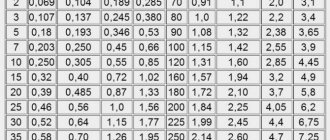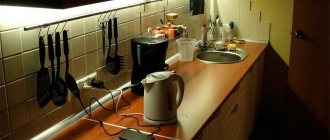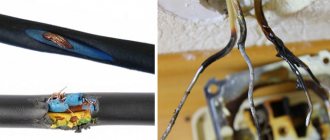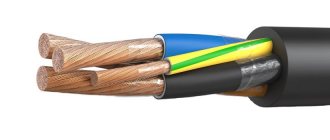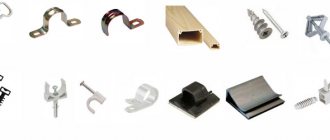According to the finished plan
As mentioned above, it is most accurate to calculate the cable length using a ready-made wiring diagram.
A well-developed plan diagram should include the following data:
- The number of sockets, light switches and distribution boxes in the rooms. In addition, for each element the installation height and method of connection to the electrical network must be indicated - through distribution boxes or directly from the electrical panel.
- Installation points for all appliances that will be connected to lighting lines (that is, not through sockets). These are chandeliers, spotlights, etc. For each such point, it is necessary to provide a margin of 20 centimeters plus the height of suspended ceilings, if they are installed.
- The number of cores and their cross-section for socket lines (usually sq.mm.), for connecting powerful electricity consumers (3x4 sq.mm.) and for lighting lines (sq.mm). You will need to calculate the length of each of these conductors.
You also need to decide on the method of connecting powerful electrical appliances. It is best if separate lines are laid for them from the electrical panel.
Using a ready-made plan diagram, where all this data is indicated, you can quite easily and accurately calculate the length of cables required to supply power to an apartment or private house. Ideally, at the design stage, the walls are also marked, which allows you to then use a tape measure to obtain the exact lengths of all lines.
Additionally, the following points should be taken into account when calculating:
- For each outlet group and switch, add 20 centimeters of reserve for connecting the wires in the junction box.
- For connections in the electrical panel, the margin should be about 50 cm.
- Increase the total reserve by 10-20%, which will completely eliminate the risk of unpleasant situations when literally a couple of meters of cable were not enough to connect an outlet.
Calculation of cable length for electrical wiring
Before installing the wiring, you need to correctly calculate the cable length. You can make the correct calculation using two methods. In the first method, you will need to rely on a ready-made diagram that you should have drawn up in advance. The second method involves calculating the cable length based on the total area of the rooms.
Which of these methods you choose is up to you. In this article, we described in detail how to calculate the amount of cable for electrical wiring in a private house.
Simplified method
If you do not have a ready-made wiring project and you think that you do not need it, you can use a simpler method to calculate the cable length. Even professional electricians often use this method.
In this case, we calculate the amount of cable by simply multiplying the area of the apartment or house by “4”. That is, for installing electrical wiring in an apartment with an area of 75 sq.m. we will need 4x75 - 300 meters of cable. This is, as they say, “the hospital average.” If we are talking about a large house, “stuffed” with household and digital appliances, then you can even multiply by “5”. But for a small one-room apartment, a coefficient of “3” will be enough.
However, this method allows you to find out only the total length of the wiring. But what if you are going to use different brands of wires for lighting and power lines? In this case, the number of each cable is calculated in the ratio of 2 to 3. That is, continuing the example above, out of 300 meters of cable, 120 meters will go to lighting lines, and 180 to socket lines.
Wire cross-section, however, without this it will not be possible to correctly calculate the electrical wiring. If you live in a multi-storey apartment building, then there is no need to lay communications - the builders did it for you. But when building a private house, you will have to do it yourself.
During the construction of a private house, the question will definitely arise about how to calculate the electrical wiring
Diagram to help!
It is best and most accurate to carry out the calculation by first drawing up a diagram of the electrical wiring in the house.
The prepared project must indicate the following points:
- The exact number of sockets, switches and distribution boxes, as well as the height of their mounting and the method of connection to the network (through distribution boxes in the rooms or directly from the panel). Read more about the location of sockets in the apartment in the article: https://samelectrik.ru/pravilnoe-raspolozhenie-rozetok-v-kvartire.html.
- Installation locations for all lighting fixtures in the rooms: sconces, chandeliers and, most importantly, spotlights. By the way, before calculating the length of the cable for the electrical wiring, decide on the height of the ceiling. You must understand that the margin will be about 20 cm if the ceilings do not drop, and about 50 cm if the ceiling drops by 30 cm.
- The selected cable cross-section for the socket group, connecting powerful electrical appliances and lighting lines. For example, when designing lighting, wires with a cross-section of 3 * 1.5 mm 2 are usually used; sockets require a cable with more powerful conductors - 3 * 2.5 mm 2 . As for powerful electrical appliances, even to connect the hob, a cable with a cross section of 3 * 6 mm 2 must be used (according to SP 256.1325800.2016 clause 10.2). As you understand, this is a very important point when calculating the length of the wiring, because... You will have to buy each type of wire separately in the required quantity. You can calculate the cable cross-section for power and current without any problems.
By the way, you also need to decide right away about connecting household appliances. Most likely, each group of electrical appliances will have to have a separate wire from the panel, and not just a new line from the distribution box in the room!
Having already prepared a visual wiring project, you can calculate how much cable is needed to supply electricity to a house or apartment. Of course, it would be ideal to immediately mark the walls and ceiling for wiring, and then simply use a tape measure to measure all the drawn lines and calculate the total number of each type of wire for the designed network, but, as practice shows, no one does this.
Additionally, you must make the following adjustments to the calculation that you may not have known about:
- Multiply the total number of wires by a factor of 1.1-1.2. This is a reserve that will not allow a situation where there are several meters short of the sockets and you have to go buy more material.
- For sockets and switches, leave a margin of at least 20 cm for connecting electrical wires.
- If you have not decided on the ceiling, it is better to calculate the reserve of at least 50 cm of cable for connecting the lamps.
- To assemble the distribution panel, the margin should be about 50 cm.
Using this principle, you can independently calculate the amount of materials for installing electrical wiring in a house or apartment. We will talk about a simpler calculation technology below.
Where to begin?
Today it is hardly possible to imagine modern life without electricity. Even the most ardent nature lover will not be able to do without light, an electric kettle, a computer, and so on for long. What can we say about those people who are used to living in absolutely comfortable conditions? Today, almost no household appliance can operate without electricity. You cannot choose wires at random to stretch them throughout the house to connect electricity. You need to know how to calculate the cross-section of a wire, what kind of wires there are, and so on. This is exactly what we will talk about in this article.
By power and current you can determine which wires you will need to supply electricity to the house. Even from a school physics course, I remember the formula for power (P), which can be established by multiplying voltage (U) and current (I):
If you have two values, you can easily set a third one. You should also be guided by the electricity load (current strength) on the wire. This parameter must be taken into account in any case, because a wire with too little thickness can simply burn out under increased load. At this voltage, different types of wires can support different amounts of power.
Calculation of wiring outside the home
If you live in a private house, you have probably thought more than once about how you can decorate your garden space. One option is to install outdoor lighting fixtures. Some people use flashlights with solar panels, while others run electrical lines. The wire can be laid either deep underground, using dielectric pipes, or above it.
There are several types of connection:
- single-phase;
- two-phase;
- three-phase.
On the site it directly depends on the type of water supply from the house. In most cases, a two-wire system is sufficient for minimal electricity consumption. One will be a phase, the other will be a zero. There are situations when three wires are needed to connect the cable from the house to the site. The third plays the role of the second phase. If you have a power source on your site, such as a transformer or machine, you will need to use a three-phase wiring method. Such a four-wire input is permissible only after the appropriate permission from the organization that supplies you with electricity.
Let's consider a single-phase two-wire connection on a house site. First, let's give a few recommendations:
- Before starting calculations, it is necessary to take into account the length of the cable. If the distance from the source to the site exceeds 25 meters, then it will be necessary to erect additional fastening for the wire. If your area experiences significant winds, then this distance should be reduced to 15–20 meters;
- if the cable passes over the roadway, its height must be at least 6 meters above the ground;
- It is recommended to connect the line to the house at a height of at least 3 meters.
As you know, current leaves the transformer at a voltage of 220 V. But there are situations when voltage drops occur, and much less can reach you - about 150 V. Stabilizers are created for this. where the electricity comes out. Also equip the system with network overload protection circuit breakers. The distribution panel must be located in a dry place.
You can lay the wire both underground and directly through the air. The latter option will be much more economical. In the case of lanterns along paths, it is better to get by with underground cable laying. Light bulbs must be connected in a parallel circuit. This way you will exclude the possibility of the lack of all lighting as a result of one of them burning out.
Wires, take a site plan and mark all underground and overhead electrical transmission lines. Sum up their lengths and multiply by two. This is necessary because you will need two wires.
Two approaches to cost calculation
There are two approaches to calculating the cost of electrical installation work in residential premises. Understanding these two approaches will allow the customer to correctly assess the possible costs of repairs or new electrical wiring.
Calculation by points
The first approach to calculation is based on the concept of electrical installation point. The concept of “wiring point” is conventional, but visually understandable and, as a result, widely used.
So, the electrical installation point is fully assembled and ready for connection: socket, switch, junction box. As well as wiring terminals for chandeliers, sconces, lamps.
Installation of lighting fixtures (chandeliers, sconces, lamps), as a rule, does not apply to the electrical installation point. Their installation is clothed separately.
For example, you thought and decided that you need 10 sockets, 1 chandelier, 2 sconces, 1 double switch for the chandelier and 2 switches for the sconces in your room.
Calculating the cost of electrical installation work by points shows that there are 16 points in the room. Knowing the cost of work declared by the manufacturer (for example, 300 Russian rubles), you can easily calculate the total cost of electrical installation work, excluding the cost of materials, 4800 rubles.
Calculation of the cost of electrical installation work by point is approximate, as it does not estimate additional or individual complex work. For example, you are unlikely to find an electrician who will point out the installation of an electrical panel or the installation of an additional circuit breaker. This type of work is paid separately.
Calculation by area
The second approach to calculating the cost of electrical installation is based on the area of the room. It can be found in companies engaged in serious complex repairs.
Calculating the cost of electrical installation work by area is similar to calculating repairs. There is a cost of complete electrical installation per square meter of area. As a rule, there are no additional works that are paid separately. The company bears all costs for additional work.
Related articles: A clear example of an apartment's electrical project
What is convenient and at the same time inconvenient about such a repair calculation for the customer? If you plan to install 5 outlets in a room, it will cost the same as wiring 50 outlets. For a customer with large volumes, this calculation is convenient. For a customer with small volumes, such a calculation is NOT profitable.
Calculation of electrical wiring in the apartment
First of all, you need to remember that the calculation of electrical wiring in an apartment begins with drawing up a wiring diagram. If you decide to do the wiring yourself, you need to pay special attention to the following issues:
- determination of the cross-section of wire cores;
- under what conditions the wire will be laid;
- how to connect the meter;
- grounding;
- total ;
- power grid protection.
An average one-room apartment requires a total power of 15 kW. It is more convenient to calculate power consumption if you conditionally divide the wiring into several groups. For example, sockets for:
- bathroom;
- rooms;
- kitchens;
- corridor.
And please take into account separately. This will make it easier for you to calculate the maximum load of electrical appliances in your home. If in doubt, use a special calculator that you can find on the Internet in construction forums.
Today, it is impossible to imagine any room without electricity supply. Often, in industrial, commercial and multi-storey residential buildings, the laying of electrically conductive cables is carried out by a construction company. At the same time, specialists carry out preliminary calculations of the conductive network. But, if you want to repair the wiring in an apartment with your own hands, or lay a network of electrical wires in a private house or country house, then you will have to carry out the calculations yourself.
Correct calculation of wiring in an apartment and private house
Calculation of wiring, both in an apartment and a private house, includes determining the types, length and cross-section of conductive cables. The serviceability of the system, the safety of property and the lives of residents depend on how correctly the wires are selected.
To do this, you need to decide how many and what appliances in the house will work simultaneously (for example, a refrigerator, electric stove, microwave oven, boiler). After this, you need to find out what power each device is designed for. At the same time, the power of lighting devices should also be taken into account. This can be done by finding a technical data sheet for electrical devices or a power table on the network. After this, all powers must be added up. Knowing the total power consumption of all electrical appliances in the house and the voltage in the network, it will be possible to calculate the amount of current that the cable will have to withstand and determine the cross-section of the wire.
How to calculate wiring in a house: select the cable cross-section
Why do you need to know the cable cross-section? The reliability and safety of the wiring directly depends on this indicator. Thus, an incorrectly selected cross-section (lower than the calculated one) will not correspond to the load on the system, and can cause fires. Cables with a cross-section larger than the calculated one will create difficulties during electrical installation. In addition, such wires are more expensive. Therefore, electrical wiring “in reserve” will negatively affect the construction estimate.
The cross-section of the cable for installing electrical wiring in a private house is equal to the ratio of the total power of all electrical appliances to the mains voltage.
Often, single-phase electrical networks are used in private homes. The voltage of such networks is 220 V. In three-phase networks the voltage is higher and equal to 380 V.
When choosing the cross-section of conductive cables, you must use the following recommendations:
- To create a safety margin, the power consumption of household lighting and electrical appliances should be multiplied by a constant factor of 1.5;
- The power cable leading to the outlet must have a cross-section equal to 2.5 square meters. mm;
- For lighting fixtures, a 1.5 sq. cable is suitable. mm;
- For electrical appliances with higher power, it is necessary to choose a wire cross-section that is equal to 6 square meters. mm (it is designed for a load of 8000 W);
- For a single-phase hidden type installation, the cross-sectional area of the wire must be doubled;
- The cable cross-section should be increased by 1.5 times when laying a three-phase network is closed;
- When using aluminum wires, it is necessary to take their cross-section with a reserve, since their ability to withstand high current loads for a long time is lower than that of copper wires.
To obtain the most accurate calculations of the cross-section of cables and wires, it is also necessary to take into account the type of conductor insulation and the number of cores in the cable. To obtain safe wiring, you must follow the Electrical Installation Regulations. A special online program will help you calculate the cross-section of cables for wiring electricity to a storey building.
Let's do the calculation
Any household electrical wiring in an apartment or private house starts with an input cable, which bears the entire load from appliances and lighting. To choose this cable, you need to calculate the cross-section in accordance with all the equipment in the house, so first you will have to make a complete list of them. This includes refrigerators, televisions, computers, microwaves, table lamps, climate control equipment - in general, everything that requires an outlet.
Each household appliance has its own power, and you need to find out the total power value, then multiply this number by 0.75 (coefficient). The power can be viewed on the device itself (usually there is a sticker with the necessary technical information on the bottom or back of the case). The table below includes the most common household appliances and their power consumption:
Having found the desired value, selecting the cable cross-section is not difficult. For this, there is another table that shows the dependence of cable cross-section, power and voltage. It displays data for copper cables, since no one uses aluminum cables today.
By the way, why did they abandon the use of aluminum cables and wires for electrical wiring, because similar systems worked before, and everything was fine? If you look at it, aluminum as a material is excellent for making wires - it is lightweight, conducts electricity well, is not subject to corrosion, and is completely indispensable when installing power lines. However, there is one big “BUT” that put an end to the use of aluminum wires - high electrical resistivity (2 times higher than copper). Simply put, to ensure the same conductivity, you need an aluminum conductor that is many times more powerful, and therefore heavier, than when working with copper.
Another disadvantage is that as a result of oxidation upon contact with air, a characteristic film is formed on the surface of the aluminum product, which deteriorates its quality as a conductor. At the point of electrical contact with such an oxide, increased contact resistance may occur, the contact will heat up and further increase the electrical resistance, and the wiring will burn out as a result.
But let's return to calculating the cross-section of the electrical wiring. When you have figured out the input cable, you can proceed to calculating the cross-section of cables and wires for sockets and lighting fixtures. Based on the data in the table, it becomes clear that 0.5 mm² wires should be used for lighting, and 1.5 mm² for sockets. But often more powerful wires are installed: for lighting, at least 1.5 mm², and for sockets - from 2.5 mm², if, of course, the power of the devices matches the technical characteristics of the wire.
For example, as you can see in the table, if the network voltage is 220 V, then a wire with a cross-section of 2.5 mm² will withstand a voltage of up to 27 A or 5.9 kW. In such a situation, in order to protect electricity consumers and wires, it is recommended to install a special machine with a maximum operating current of no more than 25 A.
In addition to calculating the electrical wiring load, it is necessary to take into account the length of the end-user power line. Again, we will use the table and determine the cross section for other types of load. When designing and installing wiring, do not forget about the selectivity of the machines.
Wherever you calculate the electrical wiring load - in a private house or apartment, remember that such work does not tolerate negligence, and mistakes can lead to big troubles. If you are not confident in your capabilities, it is better to entrust this to professional electricians.
Calculation of cable length: how many meters for a 5-storey building
After calculating the cross-section of cables and wires, you need to find out how much material is needed for wiring installation. An electrical wiring diagram created based on the house plan will help you determine the cable consumption.
The location of electrical installations in the circuit when designing electrical wiring must meet the requirements of SNiP 31-02 of 2001 and part 5-52 of GOST “Low-voltage electrical installations”.
If the building was recently built or is under construction, you will have to determine the length of the electrical wiring manually. This can be done using a tape measure.
When measuring the length of electrical wiring, you must follow these recommendations:
- The layout of the future network of electrical wires can be outlined using a pencil or coal;
- When measuring the length with a tape measure, you should take into account the methods of penetration and switching of wires;
- It is necessary to measure protrusions, niches, corners;
- The resulting value should be multiplied by 15% - this is a standard coefficient for technical calculations.
Calculation of cable consumption over large areas (for example, a house with 3-5 floors) can be done using mathematical calculations. So, the area of all rooms in the building (both residential and non-residential) must be multiplied by 2. The technical reserve should be added to the resulting value. So, for example, a house with an area of 330 square meters will need 759 meters of cable. The number of internal power lines in a multi-storey apartment building directly depends on the number of rooms in the apartment. So, for electrical wiring in a one-room apartment you will need less cable than, for example, in a three-room apartment. For example, about 100-105 meters of cable will be needed for electrical wiring for a two-room apartment.
Calculation of cable length using a diagram
Calculating the amount of cable will be much easier if you have already drawn up a ready-made diagram.
Here are the main points that you should have indicated on the diagram:
- It is necessary to indicate the exact number of all switches, sockets and junction boxes that will be located in the room. Also, for a more accurate calculation of the cable length, it is necessary to correctly indicate their height from the floor.
- When drawing up a diagram, be sure to indicate what cable cross-section will be used. For example, a 3x1.5 mm wire is suitable for lighting. For sockets it is better to use a powerful 3x2.5 mm wire. To connect powerful devices in your home, use a 3x4 mm wire.
You need to indicate not only the installation locations for the main lighting, but also the locations for installing additional lighting. Additional lighting includes: sconces, spotlights. Before calculating the length of the cable for the electrical wiring, you need to determine the height of the ceiling. If the ceiling does not lower, then the margin should be 20 cm. If it drops by 30 cm, then the margin should be 50 centimeters.
As you can see, in order to correctly calculate the length of the wire, it is necessary to take into account its cross-section. Then you can decide exactly how much cable you need for your apartment. It is better to decide on the cross-section for household appliances before drawing up the diagram. This is all, because it is better to connect powerful devices directly from the panel. Wiring in a bathhouse requires mandatory calculation of the circuit.
After preparing a visual project, you will understand how much cable is needed to supply electricity to a house or apartment. It will be even better if you immediately mark the walls. To do this, you just need to draw lines and calculate the total number of each wire.
You should also make some adjustments to each calculation. The main adjustments include:
- You need to multiply the entire number of wires by 1.2. Thanks to this calculation, you will not have a situation with a shortage of wires.
- For switches, the length reserve must be at least 15 cm.
- If you have not yet decided what kind of ceiling you will have, then it is better to leave 50 cm as a reserve.
- To carry out work in the distribution panel, the safety margin must be 50 cm.
Length of the main power cable in a high-rise building: how many meters for a 10-story building
Calculating the length and cross-section of the main power cable in a multi-story building may be necessary when repairing electrical wiring. Thus, residents of old apartments often change the wiring in favor of a more powerful one. At the same time, the voltage on the power cable increases. Because of this, the cable heats up and becomes unusable. A reasonable question arises about replacing the main power cable in the entrance with a cable with a larger cross-section. The main problems that residents may encounter are obtaining permission from the utilities of the housing department or homeowners association, the queue for the repair team to fulfill the application, and the cost of the cable itself.
Since the main cable runs only from the ASU to the top floor, calculating its length will not be difficult: it will be equal to the height of the house, taking into account the necessary technological clearances.
For a ten-story building, the cable length will be about 35 meters. But all these preliminary calculations can only be used to calculate the estimated cost of the cable. The exact length and cross-section should only be obtained from employees of the relevant utility company to which your home belongs.
Competent calculation of electrical wiring (video)
Calculation of electrical wiring is a complex undertaking that involves calculating the total consumed load of all lighting and electrical devices, determining the material of manufacture and cross-section of wires, and the length of the electrical wire network. When calculating electrical wiring, it is necessary to take into account the number of power-consuming equipment, its power, type and voltage in the electrical network. At the same time, it is necessary to take into account the requirements of PUE, SNiP and GOST. Only then will the electrical wiring be reliable and safe.
Calculation and selection of electrical network elements
Building a house requires many calculations. Before you begin work on arranging any communications in the house, you should carry out careful calculations and complete an electrical project. Performing preliminary calculations allows you to correctly select the necessary equipment and materials. Correctly carried out calculations allow you to make competent electrical wiring that will function without failures.
Electrical wiring in a private house
It is better to install cables in individual households before finishing work begins. Before installing electrical wiring, you should think about where to place household appliances and calculate their total power. To calculate the total power, the power consumption of installed electrical appliances can be found on the body of each device or in the accompanying documents. After calculating the total power of all electrical appliances, the electrical currents required for consumption by these appliances are calculated. The required number of wires is determined using a tape measure. When taking measurements, you should take into account all corners and niches that are in the path of the future location of the wires. All household appliances that will be connected to the electrical network are recounted. The total wiring figure increases by 15%, this is done to obtain a standard supply of wires. To select the required cable cross-section, electricity calculations are carried out. Carrying out these calculations requires collecting some input data: how the wiring will be installed; what material the wiring will be made of; data on the power consumption of devices connected to the electrical network. Electrical installation is carried out using open and closed methods. The open method is laying the cable along the surface of the walls, the closed method is laying the wires in recesses made in advance in the plaster. After laying the cable, they are covered with plaster. Materials for the production of electrical wires are aluminum and copper. Aluminum wire is quite fragile and will quickly break if twisted several times. Copper wire has proven itself well; it can be solid (single) or stranded, consisting of several thin veins. Electrical appliances are connected to the network using wires. A higher-power household appliance requires a larger cross-section cable to connect to the network. The more wires connected to the cable through the transfer case, the larger the cross-section of that wire. After choosing the wiring installation method and the required cable cross-section, the designs of the circuit breakers are selected.
Wiring diagram and elements
The calculation of electricity in the house allows you to prepare a wiring diagram that will facilitate its installation, and in the future it is necessary when carrying out repair work so as not to damage the wiring. For small houses, you can carry out a general wiring diagram, but in large houses it is better to do it floor-by-floor or separately for each room. The electrical network consists of the following elements: electrical panels, meters, wires or cables, switches, transfer boxes, circuit breakers, sockets, insulating material and materials connecting the wires. Devices and network components, and special electrical equipment are mounted in electrical panels. To calculate the consumed electricity, single-phase devices are installed in the network that measure current with parameters of 220V/50Hz and three-phase meters that measure current with parameters of 380V/50Hz. Automatic circuit breakers are designed to open the circuit when it is overloaded or short-circuited. The material for their manufacture is fireproof plastic. In a private house, one-, two- and three-core copper cable is used. Cables made of different metals are connected using special connecting blocks. Multicore copper cables can be connected to each other by soldering. Insulation of connections is carried out using insulating tape made of polyvinyl chloride or cotton tape impregnated with a special impregnation. Heat shrink insulation is gaining popularity. This is insulation in the form of a tube, which, when heated, contracts and seals the connection completely, without the ability to disconnect it.
Which wire to choose?
This question arises when it is necessary to replace the old electrical wiring or lay a new one
.
Selecting wires is a responsible undertaking.
Considering the number of electrical appliances, choosing the right wires
for a modern home becomes very important.
The first thing you need to think about is the choice of wire cross-section. The larger the cross-sectional area of the wire, the greater the current that can pass through it and, accordingly, the greater the power. But this does not mean that it is best to take the thickest cable and lay it everywhere. This can of course be done, but at least it is not economical. It is much better to determine what power the consumer has and select the wire cross-section for it. To correctly select the wire cross-section, you can use the table below.
Table of power and wire cross-section
| Current, AMPERE | Copper, 220v | aluminum | section | Note | ||
| power, kWt | power, kWt | wires, mm2 | ||||
| 11 | 2.4 | 0.5 mm2 | ||||
| 15 | 3.3 | 0.75 | ||||
| 17 | 3.7 | 1.0 | ||||
| 23 | 5.0 | 1.5 | ||||
| 26 | 5.7 | 2.0 | ||||
| 30 | 6.6 | 5.2 | 2.5 | |||
| 41 | 9.0 | 7.0 | 4.0 | |||
| 50 | 11 | 8.5 | 6.0 | |||
| 80 | 17 | 13 | 10 | |||
| 100 | 22 | 16 | 16 | |||
| 140 | 30 | 23 | 25 | |||
I will say right away that usually the maximum power supplied to the apartment does not exceed 6.6 kW. And therefore, it is not advisable to choose a wire with a cross-section of more than 2.5 mm 2.
Another question that arises based on this table: is it necessary to use wire with a cross-section of 2.5 mm 2 everywhere. Of course, this is acceptable, but it is not very economical. It is cheaper and more correct, for example, to use wire with a smaller cross-section for lighting. Determining the required cross-section is quite simple; to do this, just sum up the power of the consumers of the line you are making.
Now let's look at the question: which wire is better, copper or aluminum? Without going into details, I will say that for electrical wiring in a room it is better to use copper wire, preferably twisted. First, copper wire can withstand more current.
And secondly, it is easier to work with twisted copper wire; it bends well and does not break. We figured out the cross-section and material of the wires. Now let's consider this question: how many cores should a wire have? If the house or apartment is equipped with grounding, then it is necessary to use a three-core cable. If grounding is not provided, then it is possible to use two wires. You will also need a three-wire wire to install a double switch. In all other cases, two-core wires are quite suitable.
And one more question: is it possible to connect copper and aluminum wires?
Answer: directly impossible. There are special connectors for this.
Correctly calculate electrical wiring
Regardless of where you lay the electrical wiring, this repair should be approached with all responsibility. Correctly calculated electrical wiring in the apartment is the key to safety! And so how to calculate the electrical wiring.
Considering that in the last 20 years the number of electrical appliances in any apartment has increased many times over, the old wiring simply cannot cope with so many consumers. To avoid these problems, you should carry out the correct calculation of the electrical wiring.
The main stage of the calculation comes down to calculating the power of consumers in order to prevent overloading of the line. Let's consider the calculation of electrical wiring in an apartment using the example of a one-room apartment.
We will proceed from the fact that we will lay the electrical wiring in a hidden way, using copper wire with a cross-section of 2.5 mm 2.
Now let's look at what electrical appliances we can have in the apartment and their power: electric kettle - 2 kW, microwave oven - 0.7 kW, air conditioner - 2 kW, washing machine - 1 kW, electric water heater - 2 kW, iron - 2 kW, oil heater - 2 kW , other small electrical appliances and lighting from 0.5 or more.
If you add up the power of all devices, it will be clear that if they are not all turned on at the same time, then the permissible value will be exceeded. Therefore, they cannot be included in one line. The solution is simple: make several parallel lines (channels) of electrical wiring in the apartment. One line will go to the kitchen, the other to the room, etc. If the number of electrical appliances is greater, more lines may be required. Accordingly, each line will go to its own circuit breaker in the distribution panel. However, the power of the input cable must be taken into account.
We have decided how to approximately calculate the electrical wiring in the apartment. Now you can calculate for yourself how much and what kind of wire you need.
How to install electrical wiring correctly?
Electrical wiring in an apartment is carried out in two ways. The first method is external electrical wiring. The second method is hidden wiring. Typically, in apartments, installation is carried out using a hidden method.
The first place to start laying electrical wiring is to determine the location of future sockets and switches. After this, grooves are made in the walls; these are recesses in the walls, where wires are subsequently placed. According to the rules, the wires must first be placed in cable channels.
At the junctions of individual wires, special distribution boxes are installed. In order to avoid problems in the future with detecting the location of the wires, they are placed strictly horizontally and vertically at a distance of 20 - 30 cm from the wall, floor, or ceiling. Arranging the wires diagonally is not advisable.
Calculation of the length of power supply wires
To calculate the number of wires needed to organize a power supply network, you should lay out their most suitable routes that comply with safety standards on the plan. After this, the diagram calculates the total length of the electrical cable.
The measured wire length should be multiplied by a factor of 1.2. In other words, wires should be purchased with a small margin, since during the electrical installation work, overspending is quite likely. You should also not forget about possible small blots in calculating the length according to the diagram. Buying a wire with a reserve will not greatly change the total cost of the apartment power supply project.
An example of an apartment power supply project
Back
Forward
In residential premises, it is best to use three-core copper wires with a cross-section that is selected based on the individual characteristics of the network, usually 2.5 mm square. For hidden wiring, the wires must be laid in a special corrugated tube placed in the gutters of the walls. The figure below shows a table for selecting wire cross-sections.
Below you can use the online calculator to calculate the cost of designing power supply networks:

